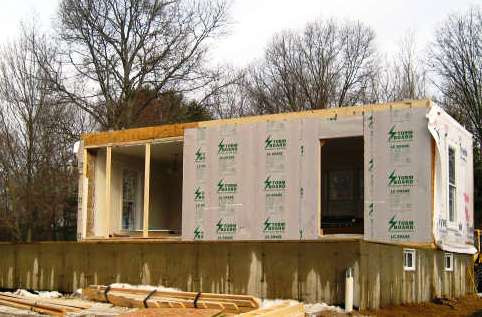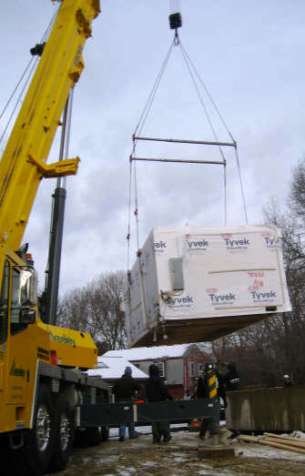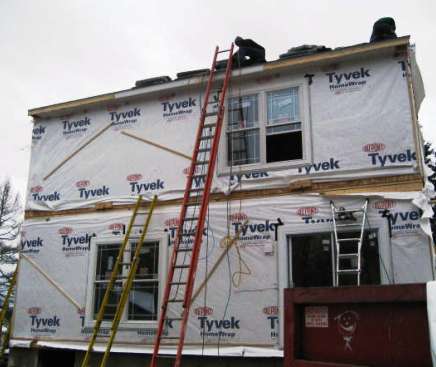Custom modular homes have become the construction method of choice for the quality conscious and cost conscious house buyer. The best-built modular homes are not just as good as the vast majority of stick built homes they are better built. The advantages are many, from better materials, to state-of-the-art construction technology, to superior finished quality, to saved time and money. And the customer gains all of these things without sacrificing amenities.
 When you add up all the labor, material and time savings inherent in the modular building process, you will find that the price of a modular home is generally lower than a traditionally built home of comparable size. And you will keep saving Modular home builder – work beginsmoney year after year, as the energy efficiency of your home keeps your heating and cooling bills low.
When you add up all the labor, material and time savings inherent in the modular building process, you will find that the price of a modular home is generally lower than a traditionally built home of comparable size. And you will keep saving Modular home builder – work beginsmoney year after year, as the energy efficiency of your home keeps your heating and cooling bills low.
We are proud to be a builder for Professional Building Systems who is the top modular home builder in the country dedicated to custom building your home. Professional Building Systems is recognized for their quality, utilizing the top brands, flexibility in design, and abundant choices in options and upgrades at the best prices! Using a unique process called off-site residential construction, they are able to offer an unparalleled combination of quality and value. They bring the building of all the critical structural components indoors. No longer do homes have to be built in the rain and the mud. This is a smarter, faster way to build your new home.
The personnel who build modular homes are trained to do very specific tasks. These men and women are specialists who have acquired a high degree of skill to carry out their task. The use of modern technology and factory production systems is only part of the story at a modular factory, since all modular homes still require the hands-on effort of experienced carpenters, electricians, roofers, and plumbers who take pride in their work.
 Building in a modern modular home factory means building under climate controlled conditions. This enables manufacturers to eliminate two problems, which plague stick builders, particularly in the Northeast. First, it allows them to avoid weather-related defects: moisture saturation by the lumber, drywall and insulation; warping of walls and doors; freezing and cracking of brittle materials; and other ravages of the elements. SecA crane helps install the modular homeondly, a factory environment enables modular companies to avoid weather-related delays that prevent the Customer from keeping his or her move-in date on schedule.
Building in a modern modular home factory means building under climate controlled conditions. This enables manufacturers to eliminate two problems, which plague stick builders, particularly in the Northeast. First, it allows them to avoid weather-related defects: moisture saturation by the lumber, drywall and insulation; warping of walls and doors; freezing and cracking of brittle materials; and other ravages of the elements. SecA crane helps install the modular homeondly, a factory environment enables modular companies to avoid weather-related delays that prevent the Customer from keeping his or her move-in date on schedule.
Only the highest quality, kiln dried lumber can be used, because warped, badly knotted or splintered pieces would jam the finely tuned assembly line jigs. This means that better materials, applied with tighter specifications, go into modular homes.
Because modular homes have to be shipped over the road and then be lifted onto the foundation with a crane, they are built stronger than more conventionally built homes. Major components, such as walls, floors, and ceilings, are not only nailed together but often screwed and lag bolted together also, and they are bonded with a special adhesive. This double fastening enables modular homes to be sturdy enough to withstand miles of travel and lifted by a crane, something no stick built house could survive without serious structural damage.
The tighter construction of prefabricated homes greatly improves their energy efficiency. For example, hand packed insulation around electrical fixtures and caulking along exterior sheathing seams helps to eliminate infiltration of cold air in the winter and hot air in the summer.
At each stage from framing to finishing, there is quality control stations set up to monitor the quality of the workmanship. A full-time, seasoned quality control inspector travels from station to station with extensive checklists of performance standards. In addition, a specially trained inspector from the state-approved third party inspection agency inspects every home as it moves down the line.
Manufacturers can customize a home’s interiors as well as exteriors, according to the Customer’s needs. Open floor plans, steeply pitched roofs, bay and bow windows, cur.ved stairways, vaulted and cathedral ceilings, skylights, reversed gables, garages, angle bay towers, central vacuum cleaners, central air condition, whirlpool tubs and fireplaces are just a few of the many, many options that Customers routinely add to the standard floor plans.
After a Customer’s house is set on the foundation, the Customer can add still more of his or her own personal touches by customizing it with porches, balconies, decks, sunrooms, etc. Modular manufacturers can also take the Customer’s own plans and build him, or her, an entirely new design at the factory.
 Typically, modular homes are delivered to the site in 8 weeks, and they are ready to “move into” in another 5 to 10 weeks, depending on the size of the home and amount of required on-site finish. This means that the Customer can usually move into his or her home in about 3-5 months. Today, it is fairly common for an anxious buyer to wait 6 months to a year for a stick built house. Even the most efficient stick builder is significantly limited by a 3 to 5 man crew, which must travel from job to job, rather than the modular manufacturer’s 150-man crew, which always works at the same location.
Typically, modular homes are delivered to the site in 8 weeks, and they are ready to “move into” in another 5 to 10 weeks, depending on the size of the home and amount of required on-site finish. This means that the Customer can usually move into his or her home in about 3-5 months. Today, it is fairly common for an anxious buyer to wait 6 months to a year for a stick built house. Even the most efficient stick builder is significantly limited by a 3 to 5 man crew, which must travel from job to job, rather than the modular manufacturer’s 150-man crew, which always works at the same location.
Furthermore, delays due to material back orders, no-show subcontractors, poor weather, etc. make it hard even for the most conscientious stick builder to keep the Customer on schedule. This often presents a serious problem, especially to a buyer who has already sold his or her old house and is pressured for early occupancy by the new buyers. Absorbing the costs of a motel or a rental property or coping with the stress of a few months in a relative’s home is something most people prefer to avoid.
The purchase price of a modular home is less than that of a conventionally built home because the factory is able to reduce its costs. The savings come from volume purchases of materials directly from the manufacturer (eliminating middleman markups), lower assembly line wages, and a reduction in lost and damaged materials caused by on-site weather conditions, pilferage, and vandalism. Imagine what an automobile would cost if it were built from scratch in a mechanic’s garage. The only way a stick builder can match the cost of a modular home is by building with less expensive, inferior materials, by employing unskilled labor, or by paying for fewer man-hours. This of course results in poorer construction, craftsmanship, and service.
The costs are not only lower with modular homes, they are also known in advance of construction. The modular manufacturer can offer prices that will not fluctuate. Most modular homes are 85% complete when they are shipped from the factory to the building site. In fact, the price is guaranteed, regardless of cost increases to the factory for materials and labor.
Pro’s Edge Quality Homes will be happy to discuss these points with you at your convenience. As custom modular home builders we serve Essex County and part of Middlesex County in Massachusetts. We also build modular homes in Rockingham and Strafford Counties in New Hampshire.
